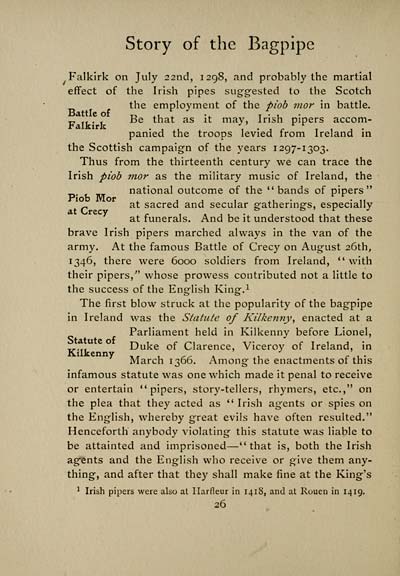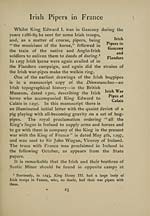Inglis Collection of printed music > Printed text > Story of the bagpipe
(52) Page 26
Download files
Complete book:
Individual page:
Thumbnail gallery: Grid view | List view

Story of the Bagpipe
Falkirk on July 22nd, 1298, and probably the martial
effect of the Irish pipes suggested to the Scotch
_ the employment of the piob mor in battle.
Battle of D ., ; ., r • u •
jj .,, f Be that as it may, Irish pipers accom-
panied the troops levied from Ireland in
the Scottish campaign of the years 1297-1303.
Thus from the thirteenth century we can trace the
Irish piob mor as the military music of Ireland, the
_ national outcome of the "bands of pipers"
Piob Mor . , , , ... • «
r at sacred and secular gatherings, especially
at funerals. And be it understood that these
brave Irish pipers marched always in the van of the
army. At the famous Battle of Crecy on August 26th,
1346, there were 6000 soldiers from Ireland, " with
their pipers/' whose prowess contributed not a little to
the success of the English King. 1
The first blow struck at the popularity of the bagpipe
in Ireland was the Statute of Kilkenny, enacted at a
Parliament held in Kilkenny before Lionel,
__,„ Duke of Clarence, Vicero\ r of Ireland, in
Kilkenny «-.,->-. , r , •
March 1366. Among the enactments 01 this
infamous statute was one which made it penal to receive
or entertain "pipers, story-tellers, rhymers, etc.," on
the plea that they acted as " Irish agents or spies on
the English, whereby great evils have often resulted."
Henceforth anybody violating this statute was liable to
be attainted and imprisoned — "that is, both the Irish
agents and the English who receive or give them any-
thing, and after that they shall make fine at the King's
1 Irish pipers were also at Ilarfleur in 1418, and at Ruuen in 14 19.
26
Falkirk on July 22nd, 1298, and probably the martial
effect of the Irish pipes suggested to the Scotch
_ the employment of the piob mor in battle.
Battle of D ., ; ., r • u •
jj .,, f Be that as it may, Irish pipers accom-
panied the troops levied from Ireland in
the Scottish campaign of the years 1297-1303.
Thus from the thirteenth century we can trace the
Irish piob mor as the military music of Ireland, the
_ national outcome of the "bands of pipers"
Piob Mor . , , , ... • «
r at sacred and secular gatherings, especially
at funerals. And be it understood that these
brave Irish pipers marched always in the van of the
army. At the famous Battle of Crecy on August 26th,
1346, there were 6000 soldiers from Ireland, " with
their pipers/' whose prowess contributed not a little to
the success of the English King. 1
The first blow struck at the popularity of the bagpipe
in Ireland was the Statute of Kilkenny, enacted at a
Parliament held in Kilkenny before Lionel,
__,„ Duke of Clarence, Vicero\ r of Ireland, in
Kilkenny «-.,->-. , r , •
March 1366. Among the enactments 01 this
infamous statute was one which made it penal to receive
or entertain "pipers, story-tellers, rhymers, etc.," on
the plea that they acted as " Irish agents or spies on
the English, whereby great evils have often resulted."
Henceforth anybody violating this statute was liable to
be attainted and imprisoned — "that is, both the Irish
agents and the English who receive or give them any-
thing, and after that they shall make fine at the King's
1 Irish pipers were also at Ilarfleur in 1418, and at Ruuen in 14 19.
26
Set display mode to: Large image | Transcription
Images and transcriptions on this page, including medium image downloads, may be used under the Creative Commons Attribution 4.0 International Licence unless otherwise stated. ![]()
| Special collections of printed music > Inglis Collection of printed music > Printed text > Story of the bagpipe > (52) Page 26 |
|---|
| Permanent URL | https://digital.nls.uk/94509800 |
|---|
| Description | Scottish and English songs, military music and keyboard music of the 18th and 19th centuries. These items are from the collection of Alexander Wood Inglis of Glencorse (1854 to 1929). Also includes a few manuscripts, some treatises and other books on the subject. |
|---|
| Description | The Glen Collection and the Inglis Collection represent mainly 18th and 19th century Scottish music, including Scottish songs. The collections of Berlioz and Verdi collected by bibliographer Cecil Hopkinson contain contemporary and later editions of the works of the two composers Berlioz and Verdi. |
|---|

